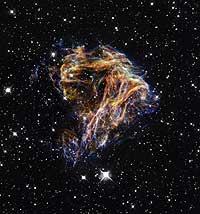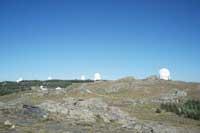Telescopes, celestial explorers

Hide the Sun in the mountains of Almeria. The sun sleeps and astronomers wake up because their working day starts at night. That is when the astronomical observatory of Calar Alto opens, nothing more obscure. They open the dome and discover a piece of sky for the giant telescope. The terrible monster is heading toward the sky, and as the sun rises, it explores the sky. Just open the petals that cover the eye of the telescope. Lens has been exposed.
It is the second largest telescope in Europe working. The largest lens has a diameter of 3.5 m. It was established by the Max Planck Institute of Germany in the mountains of Andalusia at 2,200 m of height and is currently managed by the Andalusian Institute of Astronomy.
In the darkness of the night, giant telescopes detect any source of light emission, however weak the light may be, that we would not have seen at all. In fact, to amplify the signal of light coming from the sky they use a system of two mirrors.
The spectrometer transmits to the computer by fiber optic the information of the light corresponding to each part of the sky. Using hundreds of optical fibers they manage to separate exactly where the light from the universe comes from.
But if someone expects to see amazing images of this kind from the telescope, he is very wrong. Astrophysicists see the sky formed by stripes, as they receive each luminous sign as a spectrum. The interpretation of these spectra is the most important work. Therefore, the astrophysicists of Calar Alto spend the night interpreting spectra, and the giant telescope continues to look at the sky deciphering the lights of the universe in search of black holes, brown dwarfs and new planets and stars.

Giant telescopes are spectacular. But they have a problem: astronomers say that looking at the sky from Earth is like trying to meet a person outside the bottom of a pool full of water. That is, the pool water deforms the image and the atmosphere of the Earth does the same. Therefore, astronomers seek to use the famous Hubble telescope, located outside our atmosphere. But very few can. Eibarrés Javier Gorosabel has been one of the lucky ones.
In fact, Hubble is like a terrestrial telescope, but in this case it is located on an artificial satellite that revolves around our planet. The telescope has a 5-story house height and a 2.5 m diameter lens. It is therefore less than the Calar Alto telescope. But being out of the atmosphere, it offers much better images than the largest telescope on Earth and also without deformations caused by the atmosphere. Thus he gets the images farthest from the universe.
Therefore, the Gorosábel team has used this special telescope. They investigate the gamma ray explosions that take place in the Universe and that, for many, are the most spectacular explosions of the Universe after the Big Bang. In these explosions a huge energy is released: They release in a few seconds the energy that the Sun has emitted since its foundation 5,000 million years ago.
Therefore, when satellites detect an explosion of gamma rays, astrophysicists receive a call and begin to work fully. No matter where they are and what time of day. The priority is explosions. They pick up the position of the explosion and place the largest telescopes on Earth, as well as Hubble himself, looking there.

However, scientists have not yet discovered how these terrible explosions occur; they do not know what happens in the universe when such energy explosions occur.
To find out if it is a consequence of the explosion of the stars or the fusion of black holes, the Gorosábel team analyzed the images taken by the telescopes to identify where the gamma rays come from.
The most surprising thing is that these explosions of stars are not an explosion at present. Although light is the fastest known, the universe is so large that billions of years pass until gamma rays reach Earth. Those detected are, therefore, explosions that have occurred long ago, of pioneering stars that participated in the creation of the universe.
The advantage that light takes so long to reach Earth is that we are still able to observe the phenomena that have occurred at the origin of the universe, so we are in time to clarify the origin of the universe.
Published in 7K.
Buletina
Bidali zure helbide elektronikoa eta jaso asteroko buletina zure sarrera-ontzian











